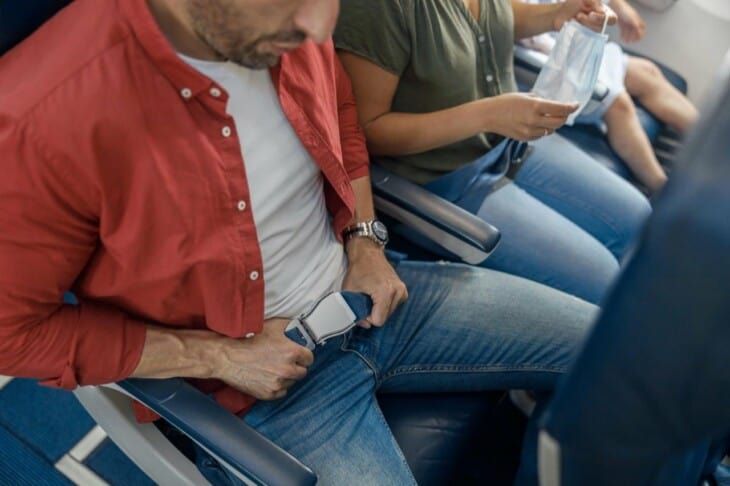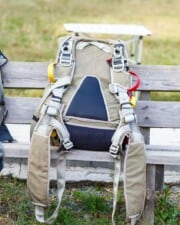Planes have a lot of equipment in place to keep passengers safe, from life rafts and oxygen masks in case of emergency to the very simple seat belt. However, you may be wondering what a seat belt will do to protect you. In case of a fiery plane crash, a thin strip of fabric is unlikely to save your life, is it?
Table of Contents
Seat belts on planes do have very important functions to protect passenger safety. Turbulence can cause serious injury that passengers can avoid by wearing seat belts. Seat belts also protect from injury and even death during small on-the-ground collisions and other incidents.
There are a surprising number of myths around airplane seat belts. Here is everything you need to know about planes and seat belts.
How Do Seat Belts Protect Passenger Safety?
The reason planes have seat belts is to protect passenger safety. Even though a seat belt may not do much to protect you from a crash or a plane falling into the ocean, it will protect you from injury during other incidents.
It turns out that crashes are not the only way that airline passengers can get injured. The most common time when passengers get injured is during turbulence. When a plane hits turbulence, the cabin usually rapidly drops and jerks around. Everything that is not strapped down, from beverage carts to errant passengers, will get hurt in the turmoil.
Official statistics estimate that about 60 passengers each year get injured during turbulence due to not wearing their seatbelts. Turbulence-related injuries include broken bones and twisted ankles from falling in the aisles and even severe concussions from the cabin ceiling bumping down into the passenger’s head.
Restraining yourself in your seat will prevent most of these turbulence-related injuries or at least keep them to a minimum. Seat belts can also protect passengers and crew during other common causes of minor accidents, such as collisions on the runway and rough landings.
Can Seat Belts Ever Hurt You?
Some people argue that seat belts increase your risk of severe injury or even death during more dangerous accidents. Some will claim that seat belts cause internal bruising as they dig into your skin, a myth going back to the 1950s. Others say that seat belts slow down your chances of evacuating in case of a fire or watery landing.
However, both of these claims have been proven wrong. Experts say that the flap of airplane seat belts is designed to release quickly, so it shouldn’t affect your ability to evacuate. On the other hand, getting injured during a crash landing because you weren’t buckled up will certainly affect your ability to evacuate.
There is also no proof that seat belts cause damage to internal organs during crash landings. This myth was promoted by one autopsy in the 1950s and largely dispelled when the real cause of death of passengers was revealed.
It is important that seat belts fit snugly but not too tightly for comfort and for safety. That is why many bigger passengers carry or request seat belt extenders and why there are campaigns to make airplane lap belts fit people of all bodies.
When Do You Have to Wear a Seat Belt on a Plane?
Since seat belts are in place for passenger safety, there are also guidelines for when passengers should wear them.

Passengers are required to wear seat belts during taxi, takeoff, and landing. These are the periods when injuries are most likely to occur because the plane is moving and changing altitude very rapidly. When the plane is on the runway, it is also possible that, due to miscommunication, it could crash into another plane or a terminal building. Passengers wearing seat belts will minimize their injuries.
During a flight, pilots will turn on the “fasten seatbelt” sign when their meteorological maps and radar show a pocket of turbulence coming up ahead. However, many airlines recommend fastening seat belts whenever possible (and flight attendants will include it in their safety demonstrations) because pilots cannot predict hitting Clean Air Turbulence, which can be very dangerous.
Do Planes Have Seat Belts to Identify Bodies?
Some people believe that planes require passengers to wear seat belts because that helps the planes identify the bodies during a crash. However, this is a false conspiracy theory.
First of all, passengers are not required to stay in their assigned seats at all times. Some will move seats during the flight, while others get up to use the bathroom. Some airlines, such as Southwest Airlines, don’t have assigned seating at all.
Secondly, if a fiery plane crash kills everyone on board, then the airline can just assume that all of the passengers on the manifesto are dead. As morbid as it seems, there are other ways to identify remains other than seat belts.
Related Posts












